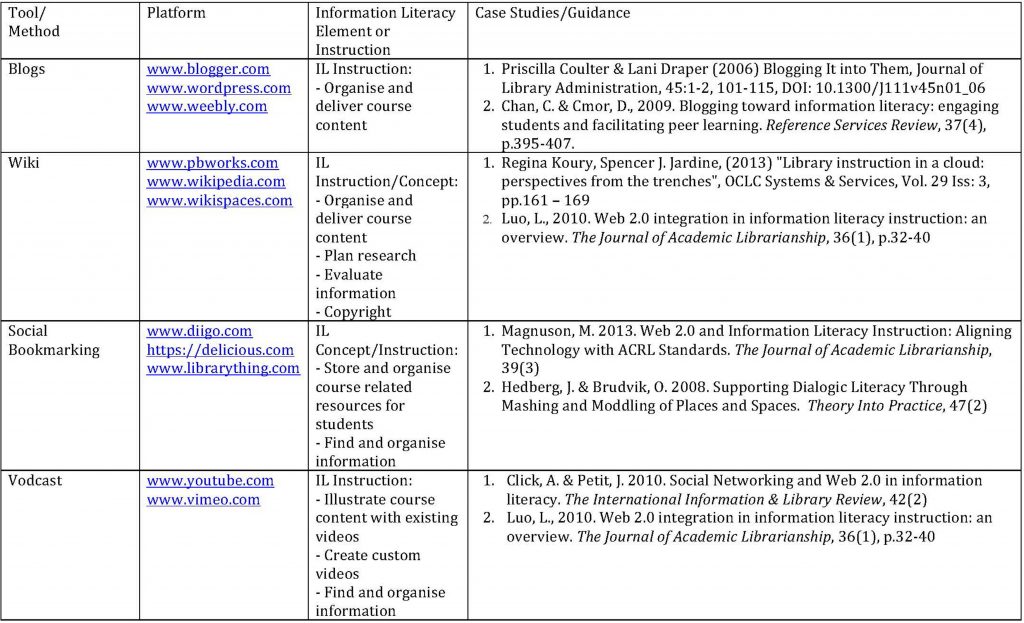
Student employability is a top priority for higher education institutions worldwide. Thus many educators are actively seeking ways to improve their teaching practices so that students are not just learning the skills necessary for competency in the subject area, but also for real world application. According to the American Library Association, “information literacy is the set of skills needed to find, retrieve, analyse, and use information.” I contend that embedding information literacy skills into the core curriculum, regardless of the subject, will lead to not only better academic performance but a readiness for the real world.
Challenges
One of the challenges is that the language of academia varies greatly from the language of business. So because the term “information literacy” does not readily translate into the knowledge, skills, and abilities of the business world “business does not understand the role that information literacy plays in the knowledge economy, in the growth of the knowledge worker, and especially in the support of the corporation of the learning organization. Even when corporations acknowledge information literacy, they have not adopted it as a core competency” (O’Sullivan, 2002). So, “when the business community does not explicitly acknowledge the importance of information literacy, faculty are slow to integrate the teaching of information literacy skills in their classes, and business schools do not build information literacy into their curriculum goals” (Klusek and Bornstein, 2009). Yet, Conley and Gil (2011) acknowledge Peter Drucker (1994) in that he “pointed out that organizations are being rebuilt around information… He said that executives need different types of information from secondary sources for them to be able to identify environmental threats and opportunities that will affect their industry.” While more educators are getting on board with this line of thinking, there is still progress to be made.
Getting Started
A good starting point is to consider the elements of information literacy and the curriculum in question. Plan out how the elements of information literacy can be embedded in a gradual way, as opposed to a one off session at the beginning of the year. Many students confirm that when information literacy skills are taught at the point in which they are needed, they are easier to retain and use. For example, students in the Cooney and Hiris (2005) study requested that the “second library presentation, which provided for hands-on electronic searching, [be offered] later in the semester when the students were better prepared in the course subject matter.” This embedding process can be achieved in any number of ways, for example by partnering with Subject Librarians to develop a comprehensive plan or by scaffolding your own learning design to incorporate the skills. See the video below for suggestions on how to do this.
[youtube http://www.youtube.com/watch?v=qcgy_gWr1eI]Additionally, consider adopting the use of social media tools for information literacy instruction. Magnuson states that, “Social media tools [like]… blogs, wikis, social media bookmarking sites, and YouTube… were employed to help students understand the information literacy concepts of information evaluation, information organization, and copyright” (Magnuson, 2013).
See the chart below for a few social media tools, their use in information literacy instruction and case studies to support their use.
These are just a few of the many social media tools available for use in higher education. Other tools worth mentioning are www.scoop.it, www.pbworks.com, and www.prezi.com. While there are not many scholarly articles demonstrating their use and/or effectiveness in information literacy instruction, there is a wealth of open education resources explaining their use in higher education.
Going Forward
Despite the lack of explicit acknowledgment in the business world of the necessity of information literacy skills, Klusek and Bornstein (2006) have concluded, “in addition to finding information literacy skills highly valued, we found that workers actually report using these skills in their jobs. Our job activity analysis supports the research of economists (Autor, 2003) who have studied the skill content of jobs over time and have found that many jobs have changed from routine, repetitive tasks to activities that require sophisticated thinking and complex communication.”
For academe, the implication of this research is that in order for students to develop skills valued and used in the workplace, educators, and business faculty must collaborate with librarians and information specialists to emphasize and integrate information literacy-rich assignments and instruction in their business programs. Students must master not only the subject matter content in their coursework, but also the skills of using the information necessary to tackle the problems in their coursework and later in professional life.
Klusek and Bornstein (2006)
For more information on successful faculty-librarian collaborations consider the following articles and projects:
Cooney, M., & Hiris, L. (2003). Integrating information literacy and its assessment into a graduate business course: A collaborative framework. Research Strategies, 19(3-4), 213-232.
Klusek, L. & Bornstein, J. (2006). Information Literacy Skills
for Business Careers, Journal of Business & Finance Librarianship, 11(4), 3-21
LSE Student Ambassadors for Digital Literacy (blogs.lse.ac.uk/lsesadl)
McInnis Bowers, C. V., Chew, B., Bowers, M. R., Ford, C. E., Smith, C., & Herrington, C. (2009). Interdisciplinary Synergy: A Partnership Between Business and Library Faculty and Its Effects on Students’ Information Literacy. Journal of Business & Finance Librarianship, 12(2), 110-127.
